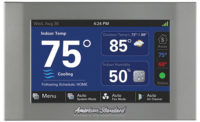Most states have yet to adopt the most current residential building codes. And, while current residential model building codes require higher ventilation rates and energy-efficiency requirements than ever before, they still lag behind commercial codes.
“You don’t have universal code acceptance like you do on the commercial side, and there’s no universal acceptance of ASHRAE Standard 62.2 in any of the codes,” said Drake Erbe, chair of ASHRAE Standard 90.1 and vice president of market development at Airxchange Inc. “So, while you might have 62.2-2001, you don’t have the most current version being adopted.”
Still, increasingly demanding standards and regulations are having a clear impact on the energy efficiency and effectiveness of products used in residential ventilation and air movement, including fans, dampers, blowers, and energy recovery units.
Motor Energy Upgrades
Megan Leick, spokesperson for Aprilaire, said increased standards have resulted in improved motor efficiency in recent years.
“ASHRAE 62.2 is changing, and in some states, the IECC [International Energy Conservation Code] energy efficiency, 2.8 cfm per watt, is becoming code,” Leick said. “In those states, the blower motor must meet that efficiency. Now, there is a choice to use an ECM with the HVAC furnace and small air handlers fans, making them more energy efficient.”
“Low-cost, poorly performing fans are being coded out nationally,” agreed Ken Nelson, Northwest regional sales manager at Panasonic Eco Solutions North America. “The fan market, as a whole, is getting more efficient and quiet. This rising tide even has Panasonic raising its bar of efficiency. We continue to redefine what WhisperQuiet means — Panasonic fans are truly whisper quiet.”
Jalena Pfister, spokesperson for Continental Fan Mfg. Inc., agreed that lower-cost, noisy fans are going away. “They have become more efficient and quieter,” she said. “HVI [Home Ventilating Institute] and Energy Star requirements have driven this, and ASHRAE 62.2 is driving more efficient fans and controls to meet the requirement.”
Matt Menard, market manager, air conditioning, ebm-papst Inc., said the company has a simple philosophy: “Every new product designed must be economically and ecologically superior to its predecessor. “We strive to make our products more efficient while reducing the acoustics in every new generation of product,” he said. “At the heart of our ecologically friendly products is our award-winning electronically commutated (EC) technology integrated into the electric motors. ECMs and fans can be easily controlled, are maintenance-free, offer outstanding efficiency, and have a considerably long service life.”
Pat Nielsen, marketing manager, balanced ventilation system, Broan-NuTone LLC, said fans are also becoming easier to install.
“We are focused on helping our contractor customers save time and money,” he said. “The new ULTRA™ Pro fan, for example, can be installed in minutes with no attic access because of its unique telescoping mounting frame, which can collapse together to fit through drywall openings and then expand once above the ceiling.”
Whole-Home Ventilation
Another trend Erbe noted is the move toward whole-home ventilation, especially in new homes or homes that have been sealed. He added that energy recovery is becoming a bigger part of ventilation on the residential side, especially in new homes.
“When you have whole-house ventilation in a tight environment, you need energy recovery,” he said. “You need to bring in the outside air to lower the level of all the pollutants simultaneously, then you need to be able to use that airstream to transfer the energy, then let it exhaust out. Just the idea of bringing something in, treating it, and throwing it back out — that’s going to use energy, not save energy.”
Jay T. Ayers, geothermal and IAQ product manager, HVAC residential North America, Ingersoll Rand, agreed that “some form of controlled ventilation will be required in all residential construction when the standard is adopted into state and local building codes.” He added that the FreshEffects™ air filtration system from Trane, a brand of Ingersoll Rand, accomplishes that task.
“A system like this exchanges a small amount of indoor air with outdoor air and recovers about 80 percent of the sensible heat transfer and mitigates latent heat transfer at the same time,” Ayers said. “FreshEffects will meet the requirements of 62.2-2013 and only uses the energy equivalent of a couple of 100-watt light bulbs.”
Similarly, Aprilaire offers the Home Comfort Control™ (8620 and 8910), which provides “an unprecedented opportunity to actively manage ventilation, as well as every other aspect of indoor air quality throughout your home,” Leick said. “That includes air purity, humidity, and temperature — all from one simple and easy-to-operate control.”
What’s Next?
Carl Redner, president of General Filters Inc., said every home — especially new homes — needs ventilation or air treatment equipment to remove odors, correct humidity, and address indoor pollution as well as stale air.
“To keep windows open in these times is not reasonable due to weather conditions, safety concerns, and noise,” he said. “Today’s homes are being built tighter and have greatly reduced, if not eliminated, the natural exchange of inside air.”
Nielsen said tighter envelope construction has made ventilation and IAQ a higher priority than ever before. “The International Residential Code (IRC) and International Mechanical Code (IMC) have addressed the impact of airtight constructions on indoor air quality by adding make-up air regulations for larger-volume kitchen range hoods,” he said.
Nelson predicted “we’ll be seeing more balanced ventilation requirements in the market” in the future. “I think we’ll see more ERV/HRV applications as well as more complex ventilation controls,” he added.
Erbe said the future of residential ventilation and air movement will be dictated, at least in part, by the health and comfort needs of homeowners. “Outside air is important, and the whole idea of dilution of pollutants instead of paying a bunch of money to treat those pollutants is the name of the game,” he said. “People need outside air, and they don’t feel good if they don’t have it.”
Publication date: 4/21/2014
Want more HVAC industry news and information? Join The NEWS on Facebook, Twitter, and LinkedIn today!











